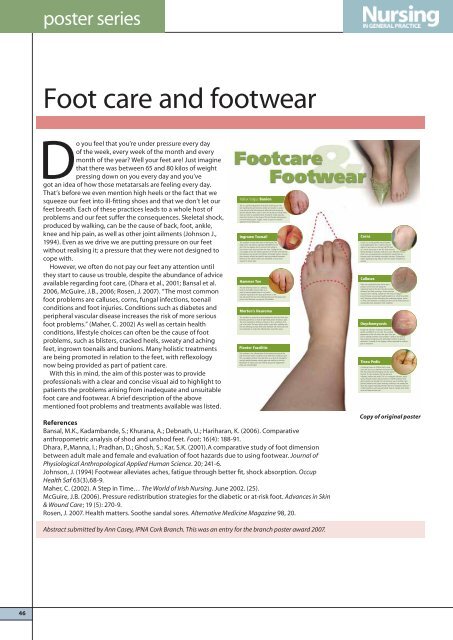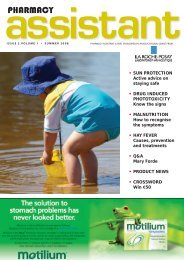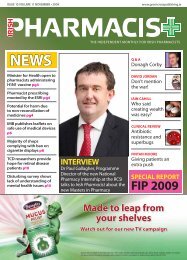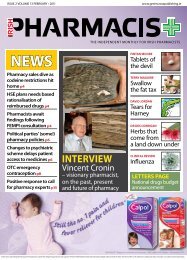veNTIlATIoN - Green Cross Publishing
veNTIlATIoN - Green Cross Publishing
veNTIlATIoN - Green Cross Publishing
You also want an ePaper? Increase the reach of your titles
YUMPU automatically turns print PDFs into web optimized ePapers that Google loves.
46<br />
poster series<br />
Foot care and footwear<br />
Do you feel that you’re under pressure every day<br />
of the week, every week of the month and every<br />
month of the year? Well your feet are! Just imagine<br />
that there was between 65 and 80 kilos of weight<br />
pressing down on you every day and you’ve<br />
got an idea of how those metatarsals are feeling every day.<br />
That’s before we even mention high heels or the fact that we<br />
squeeze our feet into ill-fitting shoes and that we don’t let our<br />
feet breath. Each of these practices leads to a whole host of<br />
problems and our feet suffer the consequences. Skeletal shock,<br />
produced by walking, can be the cause of back, foot, ankle,<br />
knee and hip pain, as well as other joint ailments (Johnson J.,<br />
1994). Even as we drive we are putting pressure on our feet<br />
without realising it; a pressure that they were not designed to<br />
cope with.<br />
However, we often do not pay our feet any attention until<br />
they start to cause us trouble, despite the abundance of advice<br />
available regarding foot care, (Dhara et al., 2001; Bansal et al.<br />
2006, McGuire, J.B., 2006; Rosen, J. 2007). “The most common<br />
foot problems are calluses, corns, fungal infections, toenail<br />
conditions and foot injuries. Conditions such as diabetes and<br />
peripheral vascular disease increases the risk of more serious<br />
foot problems.” (Maher, C. 2002) As well as certain health<br />
conditions, lifestyle choices can often be the cause of foot<br />
problems, such as blisters, cracked heels, sweaty and aching<br />
feet, ingrown toenails and bunions. Many holistic treatments<br />
are being promoted in relation to the feet, with reflexology<br />
now being provided as part of patient care.<br />
With this in mind, the aim of this poster was to provide<br />
professionals with a clear and concise visual aid to highlight to<br />
patients the problems arising from inadequate and unsuitable<br />
foot care and footwear. A brief description of the above<br />
mentioned foot problems and treatments available was listed.<br />
Hallux Valgus Bunion<br />
This is a painful enlargement of the joint of the big toe. The<br />
skin overlying the joint becomes tender and swollen. In severe<br />
cases the joint itself often becomes deformed and the big toe<br />
deviates laterally either under or over the second toe. Poorly fitting<br />
shoes are often a causitative factor. Treatment include wearing<br />
shoes that conform to the shape of the foot thereby relieving pressure<br />
and reducing pain .Surgery is also an option to improve<br />
appearance and reduce pain.<br />
Ingrown Toenail<br />
This condition is more often seen on the big toe. The<br />
edges of the nail become painfully embedded into the<br />
skin. This may happen due to incorrect nail cutting or<br />
from shoe or sock pressure within the shoe. Cutting the toe<br />
nail straight across and relieving pressure on the foot with wide toe<br />
box footwear may prevent the problem. Untreated ingrown toenails<br />
often become infected and painful requiring antibiotic treatment.<br />
Removal of the toenail under local anaesthetic is some times<br />
required to relieve pain.<br />
Hammer Toe<br />
This toe deformity results in a sideways<br />
bend in the middle toe joint often as a<br />
result of narrow tipped shoes. It is a painful<br />
condition especially on the bony prominence on the<br />
top and end of the toe. Corns often develop over this bony prominence.<br />
Sized footwear may prevent this problem.<br />
Morton’s Neuroma<br />
This condition is caused by a nerve between the third and forth toes<br />
becoming pinched as a result of tight fitting shoes resulting in pain.<br />
The nerve responds by forming a neuroma, this is a build up of tissue<br />
in the nerve. This extra tissue results in pain often radiating into<br />
the toes. Wearing correctly fitted wide footwear will relieve pain and<br />
oral medication to reduce the inflamination around the nerve.<br />
Planter Fascilitis<br />
This condition is the inflammation of the connective tissue of the<br />
sole of the foot where it attaches to the heel bone resulting in pain.<br />
This may happen without injury but often as a result of unsupportative<br />
light weight footwear causing pain and swelling in the area.<br />
Medication to reduce pain and swelling along with supportative<br />
shoes are recommended.<br />
references<br />
Bansal, M.K., Kadambande, S.; Khurana, A.; Debnath, U.; Hariharan, K. (2006). Comparative<br />
anthropometric analysis of shod and unshod feet. Foot; 16(4): 188-91.<br />
Dhara, P.,Manna, I.; Pradhan, D.; Ghosh, S.; Kar, S.K. (2001).A comparative study of foot dimension<br />
between adult male and female and evaluation of foot hazards due to using footwear. Journal of<br />
Physiological Anthropological Applied Human Science. 20; 241-6.<br />
Johnson, J. (1994) Footwear alleviates aches, fatigue through better fit, shock absorption. Occup<br />
Health Saf 63(3),68-9.<br />
Maher, C. (2002). A Step in Time… The World of Irish Nursing. June 2002. (25).<br />
McGuire, J.B. (2006). Pressure redistribution strategies for the diabetic or at-risk foot. Advances in Skin<br />
& Wound Care; 19 (5): 270-9.<br />
Rosen, J. 2007. Health matters. Soothe sandal sores. Alternative Medicine Magazine 98, 20.<br />
Abstract submitted by Ann Casey, IPNA Cork Branch. This was an entry for the branch poster award 2007.<br />
Corns<br />
A corn is a circular painful area of traumatised<br />
hyperkeratotic skin. Common sites for<br />
digital or hard corns are the big and fifth toes<br />
as a result of pressure on the skin from incorrect<br />
fitting stockings or footwear. Soft corns occur between the toes,<br />
often corns on opposing toes resulting from sweaty feet can<br />
become painful and develop secondary infections. Professional<br />
advise regarding paring, filing or over the counter treatments is<br />
advised.<br />
Calluses<br />
These are caused by friction and or exact<br />
pressure on the skin over laying the<br />
metatarsal heads of the feet. The skin becomes<br />
thickened and hard resulting in further pressure<br />
and pain when walking. Calluses are the result of inappropriate<br />
footwear, unusual gait (walking pattern) or a foot bone deformity.<br />
Treatment includes identifying the underlying problem, advice<br />
on thick soled footwear or padding and skin care to relieve pressure<br />
and provide shock absorption from underfoot.<br />
Onychomycosis<br />
Fungal nail infections resulting in thickened<br />
painful and difficult to trim nails. The unsightly<br />
appearance of the nail rather than pain is the reason<br />
for seeking treatment. This condition is difficult and slow to<br />
treat requiring compliance with antifungal treatment to prevent<br />
reinfection. A sample of nail clipping is often requested for analysis<br />
prior to treatment.<br />
Tinea Pedis<br />
Commonly known as Athletes foot a scaly,<br />
itchy skin rash occurs between the fourth and<br />
fifth toes firstly then developing onto the sole of<br />
the foot. The skin between the toes becomes<br />
inflamed, swollen and smelly. This is a contagious infection, easily<br />
spread through shower and pool areas or shared footwear. Tinea<br />
pedis initially may develop from the exclusive use of synthetic type<br />
(plastic) footwear and (nylon) stockings resulting in hot sweaty feet.<br />
Good skin hygiene especially between the toes, compliance with prescribed<br />
treatments and wearing leather shoes or sandals with cotton<br />
socks will keep the feet cool.<br />
Copy of original poster










